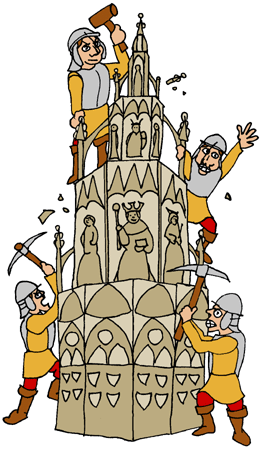|
RBH Home
Maps & Travels
Articles
Legends
Towns & Villages
Castles & Houses
Churches
Biographies
Gentry
Family History
Odds & Ends
For Kids
Teacher's Page
Mail David

|
|
 
A Place of Abbots and Affray
- Abingdon is a very ancient place. It was an enclosed Iron Age
settlement (or valley fort) and then a small Roman town.
There were also Roman Villas in the
surrounding countryside.
- Early Saxon
mercenaries
were employed in Abingdon. Their graves have been excavated, included
those of Frankish thanes
(from France).
- The name means ‘Abba’s Open Land’. Abba was probably the Queen
of Herefordshire.
- However, legend says it means ‘Abban’s Hill’. Abingdon is not
on a hill but the name supposedly came from nearby Boar’s Hill where Abban had a hermitage.
- In AD 675, a local prince called Hean set up a monastery
at Abingdon. It was an abbey and became very important. Lots of
pilgrims went there to see its collection of relics, including a nail
from the cross that Jesus died on.
- There was a Saxon palace near St. Helen’s Church. The King met his
advisors, called the ‘Witan,’ there sometimes.
- When the Vikings invaded Berkshire, they marched up from
Reading and
burnt Abingdon to the ground! A fabulous Viking sword has been found
in the Thames nearby.
- In Medieval Times, St. Edmund was born in Abingdon. He was the son
of a rich merchant who sent him to Oxford University. He eventually
became Archbishop of Canterbury.
- The King said that only Abbey tenants were allowed at the local
market in Abingdon. The townspeople were very angry. They attacked the
Abbey in 1327, smashed up the church and kicked out the monks! The
monks fled across the river and some drowned. Many of the rioters were
hanged.
- In the 1400s, Prince Humphrey, Duke of
Gloucester, ruled the country for his nephew, the boy King Henry
VI.
People didn't like him and there was a rebellion in Abingdon against
him. He came with soldiers to stop it. The head of the ringleader,
Jack Sharpe, was stuck on a pole
on London Bridge!
- All the top townspeople at that time were members of the Fraternity
of the Holy Cross. It was like a social club and they did good works.
- They put up a big market cross in the middle of the town to show how
important Abingdon was. It was the finest stone cross in England.
- In Tudor Times, King Henry VIII used to come to Abingdon to escape
the plague in London. He ‘dissolved’ the Abbey in 1539 and it was
pulled down.
- During the English Civil War, Abingdon supported King Charles.
However, the Royalists deserted the town and Parliament’s soldiers took over.
They smashed up the Market Cross in 1644.
- After the war, Abingdon had the finest town hall in England built
near the site of the Cross. The architect had previously put up the dome on St.
Paul’s Cathedral in London.
|





